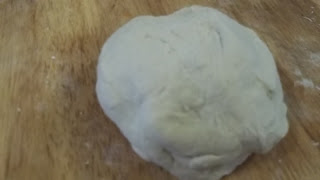One of my favourite snacks from Chinese cooking is steamed buns. I will be cooking the bread-buns based on Kenneth Lo's recipe. This time I am only doing the dough for baking 'plain steamed buns', as I am serving the buns to garnish a poultry dish.
Here is the introduction to you about the buns from the cooking book-Chinese Food- By Kenneth Lo.
Steamed buns, which are called Pao-Tzu, are famous in both north and south China. Their popularity is probably due to their convenience, as well as to the fact that they are practically self-contained meals, The savoury meat and vegetables stuffing, in their steamed raised- dough casing are well flavoured as well as filling.
A little sugar is added to the dough, and this tinge of sweetness often comes as a pleasant surprise to the westerner.
Since the gravy and meat are sealed within the bun, they are convenient for outdoor meals and picnics. A proportion of self-raising flour is used, and the bun itself is quite light. One can get through quite a number of them, although 3 or 4 is enough for most people.
The stuffing for these buns varies widely-from roast pork to sweetened black or brown bean paste (which is the most widely used sweet ingredient in Chinese food, for it is also wholesome and satisfying). Some are even stuffed with meat jelly, which turns to the gravy when the buns are steamed. These are called Soup Buns. A large amount of steam is always generated in rice cooking, and steamed buns along with other steamed items can all be cooked conveniently together in the Chinese kitchen. (Kenneth Lo)
Recipe for the dough of the buns
Ingredients:
500g
1 1/2 teaspoon dried yeat
300 ml of water
1 tablespoon sugar
The Process the way I do
The dough after proofing for over an hour
it is doubled in bulk.
It is good to learn from the master, I think the dough recipe for the steamed bun works very well. It is so light and soft. The picture is self-explanatory. However, I may suggest that covering the dough to proof is not necessary. When I opened the cover, some of the dough is on the plastic wrap cover.
Some of the dough is on the plastic wrap cover.
After proofing the dough over an hour.
It is to be continued, Stay Tuned
Until next time
Susy









No comments:
Post a Comment